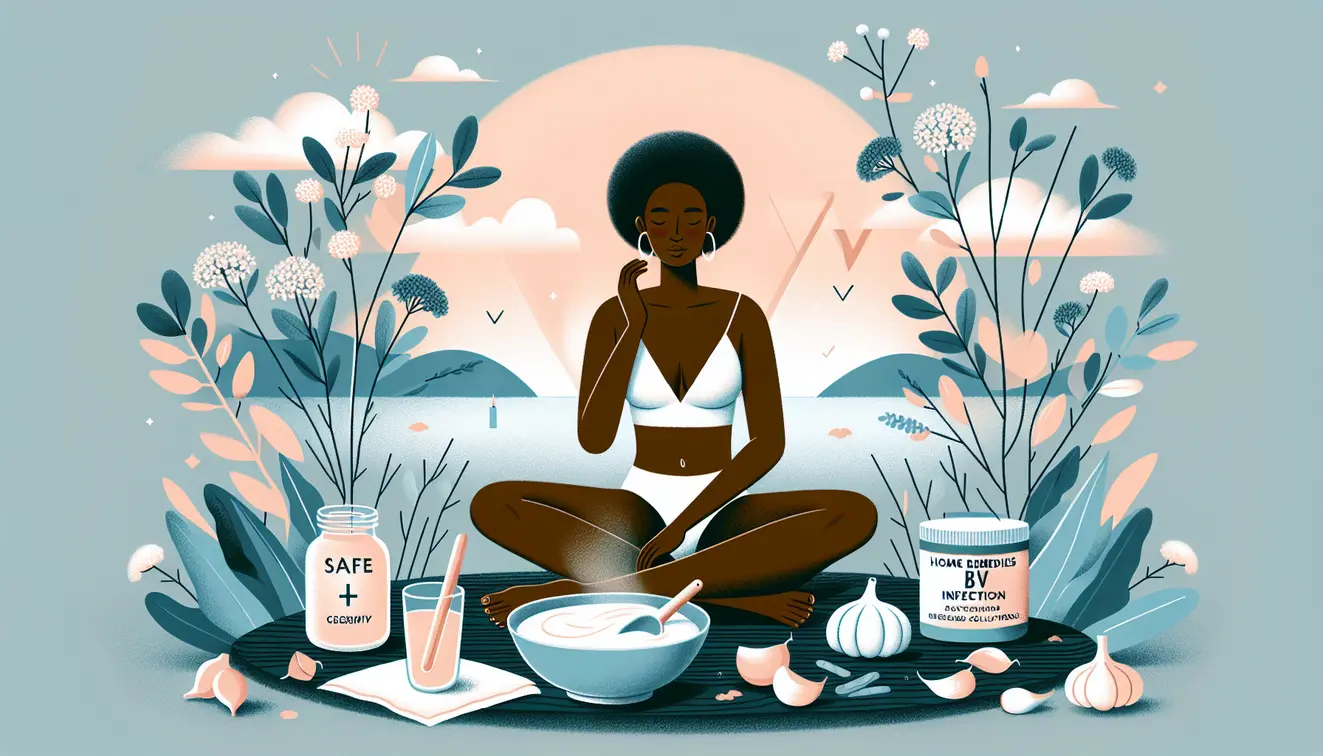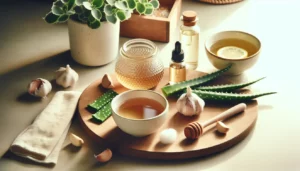Home Remedies for BV Infection: Safe and Evidence-Based Solutions for 2025
Estimated reading time: 13 minutes
Key Takeaways
- BV (bacterial vaginosis) is a common imbalance of vaginal bacteria affecting 1 in 4 women in the US.
- Home remedies can ease discomfort and may support recovery, but should not replace medical care for severe or prolonged symptoms.
- Safe home remedies include probiotics, garlic, very diluted tea tree oil, apple cider vinegar baths, and dietary adjustments. Always consult a doctor before hydrogen peroxide use.
- Avoid risky practices like douching, undiluted essential oils, and inserting unproven substances into the vagina.
- Hygiene and lifestyle habits, plus regular checkups, are crucial for prevention and long-term vaginal health.
Table of Contents
- Introduction to Home Remedies for BV Infection
- Understanding Bacterial Vaginosis (BV)
- How Home Remedies Can Support BV Management
- Top Evidence-Based Home Remedies for BV
- Lifestyle and Hygiene Tips to Prevent BV Recurrence
- Myths and Remedies to Avoid
- When Home Remedies Don’t Work: Next Steps
- Frequently Asked Questions (FAQs) About BV Home Remedies
- Additional Resources for BV Education and Support
Introduction to Home Remedies for BV Infection
Welcome to a guide crafted with care to help you navigate bacterial vaginosis, or BV, using safe, natural approaches. BV is a common condition where the balance of bacteria in the vagina shifts, leading to symptoms like unusual discharge or a fishy odor. Many women, about 1 in 4 in the US according to the CDC, experience this at some point, often seeking home remedies for privacy, cost, or a preference for nature’s touch.
I’m here to walk you through solutions grounded in evidence, while reminding you that professional medical advice is vital. If symptoms persist or worsen, please consult a healthcare provider to ensure your safety. This journey is about empowering you with knowledge and options, starting with a clear understanding of what BV entails.
Understanding Bacterial Vaginosis (BV)
Let’s dive deeper into what bacterial vaginosis really is. This condition stands out as one of the most frequent vaginal issues among women of reproductive age, differing from yeast infections due to its bacterial roots. It happens when harmful bacteria outnumber the good ones that usually keep the vaginal environment balanced. The result? Discomfort that can disrupt daily life.
The causes often tie back to certain habits or changes in the body. Risk factors include practices like douching, which can strip away protective bacteria, along with multiple sexual partners, smoking, or even hormonal shifts. Knowing these triggers helps in managing and preventing BV down the line.
When it comes to spotting BV, the signs are quite specific. Here are the key symptoms to note:
- A thin gray or white discharge.
- A distinct fishy odor, especially noticeable after sex.
- Burning or irritation during urination, though not always present.
- Sometimes itching around the vaginal area.
If you notice these, especially if they recur or linger, seeking medical help is wise. Pregnancy or unusual pain alongside these symptoms also calls for a doctor’s input to prevent complications. Let’s explore these causes, symptoms, and critical moments to seek care in more detail.
Causes and Risk Factors of BV
Understanding what sparks BV can guide you toward prevention. Here are the main culprits based on research from sources like the NIH and Mayo Clinic:
- Bacterial Imbalance: Overgrowth of harmful bacteria, often triggered by reduced levels of protective Lactobacillus.
- Douching: This practice washes away good bacteria, creating fertile ground for BV.
- Sexual Activity: Multiple partners or new sexual relationships can introduce bacterial changes.
- Smoking: It impacts overall immunity, indirectly affecting vaginal health.
- Hormonal Changes: Events like menstruation or menopause can alter bacterial balance.
Lifestyle choices play a significant role too. Tight, non-breathable clothing or poor hygiene habits can contribute to an environment where harmful bacteria thrive. Recognizing these factors empowers you to make informed changes.
Symptoms to Watch For
Identifying BV early can save unnecessary discomfort. Pay attention to these telltale signs:
- Fishy Odor: Often stronger after sexual activity, a hallmark of BV.
- Thin Discharge: Usually gray or white, different from the thicker texture of yeast infections.
- Burning Sensation: Felt during urination by some women.
- Mild Itching: Occasionally present around the vaginal opening.
While these symptoms can guide you, they’re not a substitute for professional diagnosis. Similar signs might point to other conditions, so confirmation from a healthcare provider ensures you’re on the right track.
When to Seek Medical Help
There are times when home solutions won’t suffice, and that’s perfectly okay. If symptoms stick around for over a week, or if you notice fever, severe irritation, or unusual pain, it’s time to see a doctor. This is especially crucial during pregnancy, as untreated BV can raise risks for complications.
Leaving BV unaddressed might lead to issues like pelvic inflammatory disease or a higher chance of contracting STIs, as noted by the CDC. Don’t hesitate to reach out to a healthcare provider if you’re unsure. Your health deserves that attention, and medical insight can pinpoint the best path forward.
How Home Remedies Can Support BV Management
Now that we’ve laid the groundwork, let’s talk about how nature’s arsenal can play a role in managing BV. Home remedies aren’t a cure—they can’t fully replace antibiotics prescribed by doctors—but they often help ease discomfort or support recovery. Think of them as allies that work best alongside professional treatment, especially for mild cases or preventing recurrence.
It’s vital to stick to approaches backed by some level of evidence or expert consensus, like those discussed by the NIH or Mayo Clinic. Not every remedy floating around online is safe; some, like harsh douching, can worsen the imbalance. My goal is to guide you toward options that nurture your body without risking further harm. Let’s explore remedies that hold promise based on science and real user experiences.
Top Evidence-Based Home Remedies for BV
I’ve gathered six home remedies that show potential for supporting BV management. Each comes with a clear explanation of how it might help, how to use it safely, and what research or expert input backs it up. Safety remains the priority, so precautions are included to keep you informed. Let’s walk through these options together.
Probiotics for Vaginal Health
Probiotics are often hailed as a cornerstone for restoring balance in the body, and the vagina is no exception. Strains like Lactobacillus naturally inhabit a healthy vaginal environment, helping to crowd out harmful bacteria causing BV. Studies, including those referenced by the NIH, suggest that introducing these good bacteria can support recovery.
Here’s how you can incorporate probiotics:
- Dietary Sources: Eat yogurt with live cultures or fermented foods like kefir daily.
- Supplements: Look for vaginal-specific probiotic capsules, typically 1-2 billion CFUs, after consulting a doctor.
- Consistency: Use for at least two weeks to see potential benefits.
Be mindful that probiotics may interact with certain medications. Check with a healthcare provider if you’re on antibiotics or have health conditions. This remedy ties beautifully into broader dietary habits, which we’ll touch on soon here.
Garlic as an Antimicrobial
Garlic has long been valued for its natural ability to fight bacteria, thanks to compounds like allicin. Research from PubMed highlights its antimicrobial traits, making it a candidate for supporting BV management. However, the key lies in how you use it to avoid risks.
Focus on adding garlic to your diet—think soups, stir-fries, or roasted dishes—rather than placing it directly in the vagina, which can irritate delicate tissues. Start with one clove daily in meals. Watch for digestive upset or allergies, though these are rare. Garlic offers a gentle boost when used this way, complementing other dietary shifts for vaginal health.
Tea Tree Oil (Diluted Use Only)
Tea tree oil carries antimicrobial properties that some small studies suggest could help with bacterial overgrowth. Its potent nature means safety comes first. Never apply it undiluted or internally, as it can burn or disrupt healthy flora.
Try this method for external use:
- Mix 5-10 drops of tea tree oil with a tablespoon of carrier oil like coconut or jojoba.
- Apply sparingly to the outer vaginal area to soothe irritation.
- Test on a small skin patch first to rule out sensitivity.
Evidence is limited, so view this as a supplementary option. Always prioritize medical advice over essential oils for core treatment.
Apple Cider Vinegar (ACV) Baths
Apple cider vinegar often pops up in discussions about pH balance, though its benefits for BV are mostly anecdotal. Some women report relief from odor or irritation after using it in a diluted form. Without robust clinical trials, as noted by Mayo Clinic, it’s best approached with caution.
Here’s a safe way to try it:
- Add 1-2 cups of raw, unfiltered ACV to a warm bath.
- Soak for 10-15 minutes, no more than twice a week.
- Rinse off afterward to avoid skin dryness.
Don’t use ACV directly on the vagina or overuse it—it can irritate. If discomfort arises, stop immediately and consult a professional.
Hydrogen Peroxide Rinse (Under Guidance)
Hydrogen peroxide has been explored in small studies, like those on PubMed, for reducing harmful bacteria in BV cases. It’s not a standalone fix and carries risks if misused, potentially harming good bacteria too. Guidance from a healthcare provider is non-negotiable here.
If advised, use this dilution:
- Mix one part 3% hydrogen peroxide with four parts water.
- Use as a gentle external rinse, not a douche, once daily for no more than three days.
- Stop if burning or dryness occurs.
This remedy demands caution. It’s wiser to pair it with medical treatment rather than relying on it alone.
Dietary Adjustments for Gut and Vaginal Health
Your gut and vaginal health are more connected than you might think, thanks to the immune system and microbiota links. Research from the NIH points to how diet influences bacterial balance in both areas. Supporting this connection can indirectly aid BV management.
Consider these foods:
- Prebiotics: Fuel good bacteria with bananas, onions, and asparagus.
- Probiotics: Include yogurt, kefir, or sauerkraut for live cultures.
- Hydration: Drink plenty of water to support overall body functions.
These changes aren’t a direct cure but build a foundation for recovery. Pair them with probiotics or garlic for a broader impact on your system here.
Lifestyle and Hygiene Tips to Prevent BV Recurrence
Preventing BV from returning often comes down to daily habits. Vaginal health thrives on balance, and simple adjustments can make a big difference. The CDC and Mayo Clinic emphasize hygiene and lifestyle as cornerstones of prevention, so let’s break this down into practical steps.
Start with hygiene—avoid douching at all costs, as it disrupts the natural bacterial environment. Use mild, unscented soaps for cleansing and pat the area dry to prevent moisture buildup. Clothing matters too; opt for breathable cotton underwear and avoid tight synthetic fabrics that trap heat and dampness.
Safe sexual practices help as well. Using condoms can lower the risk of bacterial shifts, especially with new or multiple partners. Beyond the body, manage stress through restful sleep or calming practices like meditation, since immunity plays a role in recurrence. Finally, schedule regular gynecological checkups to catch imbalances early. These steps, woven into your routine, create a protective shield against BV flare-ups.
Here are specific tips to follow:
- Wipe front to back after using the bathroom to avoid bacterial transfer.
- Change out of wet swimsuits or workout clothes promptly.
- Limit bubble baths or scented products near the vaginal area.
Consistency with these habits builds long-term resilience. Small efforts today can spare discomfort tomorrow.
Myths and Remedies to Avoid
Not every remedy you hear about is worth trying. Some popular ideas can do more harm than good, and I want to steer you clear of those pitfalls. The CDC and WebMD warn against practices that disrupt vaginal balance, so let’s clarify what to skip.
- Douching with Vinegar or Water: It washes away protective bacteria, worsening BV or inviting infections.
- Undiluted Essential Oils: Applied directly, they burn or irritate sensitive tissues—always dilute if used.
- Overusing Hydrogen Peroxide or ACV: Excess application disrupts healthy flora, leading to dryness or pain.
- Herbal Insertions Without Evidence: Placing unverified herbs vaginally risks infection or allergic reactions.
These approaches often stem from outdated advice or untested trends. Stick to remedies with some scientific grounding or expert support, and always check with a healthcare provider if unsure. Your safety outweighs any quick fix.
When Home Remedies Don’t Work: Next Steps
Sometimes, despite best efforts, home remedies don’t bring relief. That’s a sign to pivot toward professional care, and there’s no shame in it. If symptoms like strong odor, discharge, or irritation linger beyond seven days, or if you experience fever or intense pain, it’s time to consult a doctor.
Other red flags include:
- Symptoms during pregnancy, which raise risks for complications.
- Recurring BV despite lifestyle changes or natural attempts.
- Uncertainty if it’s BV or another condition like trichomoniasis.
Standard treatments often involve antibiotics such as metronidazole or clindamycin, as outlined by the CDC. These target the bacterial overgrowth directly, something home solutions can’t match. Misdiagnosis is a risk too—similar symptoms might point to different issues needing specific care. Trust a healthcare provider to guide you through testing and treatment for clarity and healing.
Frequently Asked Questions (FAQs) About BV Home Remedies
-
- Can BV go away on its own without treatment?
It’s possible for mild cases to resolve spontaneously, but the CDC notes risks like complications or STIs increase without intervention. Don’t wait if symptoms persist.
- Can BV go away on its own without treatment?
-
- Are home remedies safe during pregnancy?
Most carry risks without medical approval due to potential complications. Always consult a doctor before trying anything.
- Are home remedies safe during pregnancy?
-
- How long should I try a home remedy before seeking help?
Limit natural attempts to about seven days. If symptoms don’t improve or worsen, see a healthcare provider.
- How long should I try a home remedy before seeking help?
- Can BV be prevented entirely with natural methods?
Natural approaches help reduce risk through diet or hygiene, but they’re not foolproof compared to medical prevention strategies.
Additional Resources for BV Education and Support
Learning more about BV equips you to handle it with confidence. Here are trusted sources to explore for deeper insight:
- CDC Bacterial Vaginosis Page: Offers detailed facts on symptoms, risks, and treatments.
- NIH Women’s Health Resources: Provides research-based information on vaginal health.
- Mayo Clinic BV Overview: Breaks down causes and prevention in accessible terms.
Consider joining safe online communities or women’s health forums for shared experiences, but verify advice against reputable sources. For tailored guidance, reach out to a healthcare provider or connect with the WikiHomeRemedies team. We’re here to support your journey toward natural, sustainable well-being.










